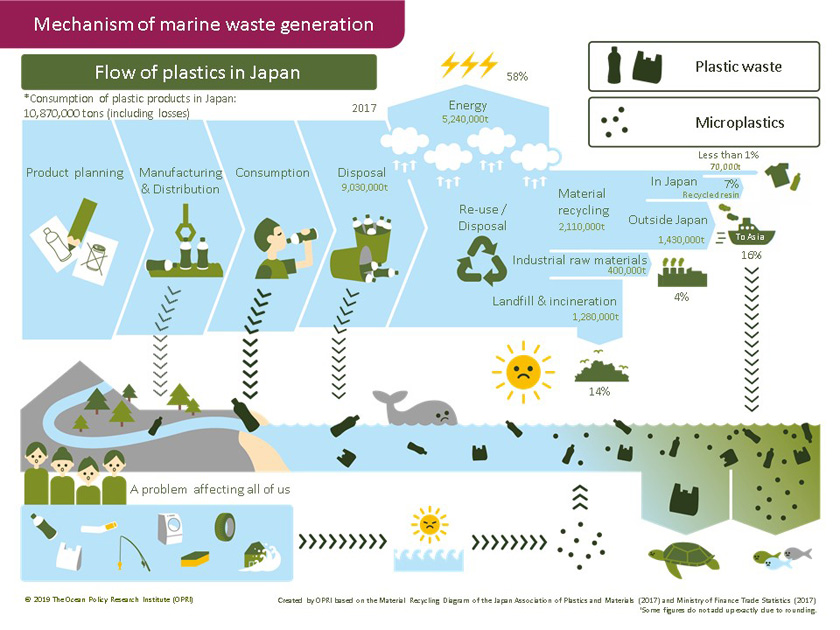The figure above summarizes the mechanism by which marine plastic waste was generated in Japan in 2016. Plastic waste is produced not only through individual consumption and disposal, but also through manufacturing and distribution. However, we do not know exactly how much plastic waste flows into the environment from each of the manufacturing, distribution, consumption, and disposal stages.
What happens to the plastic that flows into the sea?
Dr. Shioiri: Plastic does not degrade naturally, so once it reaches the ocean it is broken up into microplastic as a result of being buffeted by the waves or degraded by ultraviolet light. Once it becomes microplastic, it becomes impossible to collect. Even if, hypothetically, you filtered all of the world’s seawater to remove the microplastic, you would end up also filtering out all the microorganisms living in the sea that support marine ecosystems.
There are projects underway to clean up the plastic waste already in the ocean, but they are not sufficient to tackle the problem, right?
Dr. Shioiri: That's correct. We need to prevent waste from flowing into the sea in the first place. To do that, we must meticulously clean up and collect plastic from the places around us, such as downtown areas that are littered with plastic waste, rainwater gutters along roads, and rivers. Eighty percent of marine waste originates on land. Where there are people, you will find waste.
We are not really aware of it in everyday life, but when you think about it, the rainwater gutters at the side of the road are ultimately connected to the sea.
Dr. Shioiri: When thinking about the problems in our seas, we need to look at the connections between mountains, rivers, and the seas, and take action that incorporates all of these factors. In the past, when I was investigating waste in rivers and seas, local residents told me that the best way to pick up waste was not to throw it away in the first place! That notion has always stuck with me, and I really think they were right. Among the various kinds of marine plastic waste, it is relatively easy to reduce the materials generated during the manufacturing and distribution processes because the problem can be tackled by the industry concerned, but reducing waste in the consumption and disposal stages involves an unknown number of individuals, which makes the situation difficult to resolve. To improve, we must understand the mechanisms of distribution and movement of waste on land, work to collect waste at the source, and prevent it from flowing out into the natural world. It is also important for companies to consider the consequences as they plan, manufacture, and sell plastic products, and minimize their use.
If people don't work together, it will be difficult to solve the problem, won't it?
Dr. Shioiri: It is important for industry, local governments, and citizens to work together to take concrete action and change the awareness of society over time. Even when consumers buy eco-friendly products, if they don't separate them correctly when they dispose of them and if nobody is recycling the products down the line, even eco-friendly products will simply become more waste.
Last year, The Nippon Foundation worked with Seven-Eleven Japan Co., Ltd. and other organizations to launch the "Change for the Blue" movement to tackle marine waste. I hope that people in various positions, sectors, and industries will begin to think about resource circulation in terms of the larger framework and create a system for reducing plastic that will then in turn have an impact on society.
In addition, OPRI in cooperation with Fujisawa City in Kanagawa Prefecture, the Kanagawa Coastal Environmental Foundation, Seven-Eleven Japan Co., Ltd. and other organizations has set out to conduct policy research that will clarify the mechanisms by which plastic flows out from the land to the sea, and to create effective measures to deal with the problem of marine plastic waste.
Southeast Asia, which is densely populated and prone to typhoons and tsunamis, has natural conditions similar to those of Japan, where waste flows into the sea every year. In the future, I hope that before more consumer societies based on disposable plastic are established in the Southeast Asian region, where we are seeing remarkable economic development and population growth, we can consider the problems surrounding plastic together and take action informed by Japan’s experiences and based on the particular characteristics of the region.


